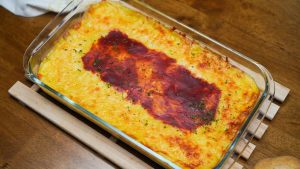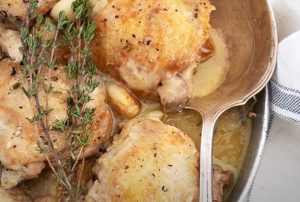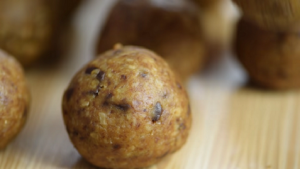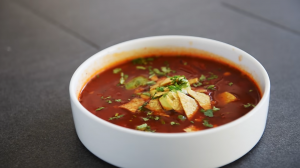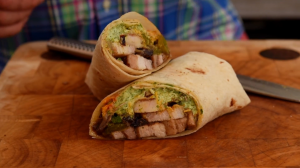Inviting the warm, earthy flavors of roasted potatoes and asparagus into your kitchen, this recipe is a perfect side dish for a family dinner or a sophisticated gathering. The garnishment of refreshing citrus dressing and aromatic tarragon adds a delightful freshness and complexity to the dish.
Most of the ingredients listed in this recipe are fairly common and should be easily available in your local supermarket. However, tarragon may not be a regular in your pantry. Known for its sweet, licorice-like flavor, tarragon is a crucial component of the dressing, adding an aromatic depth to the dish. Make sure to find fresh tarragon if available, as it offers a superior flavor compared to dried.
Ingredients for Roasted Potatoes and Asparagus
Oil: Used for roasting the vegetables, offers a crispy texture.
Red skinned potatoes: They have a firm, smooth, moist and creamy texture, which makes them perfect for roasting.
Asparagus: Adds a vibrant color and a unique, earthy flavor profile to the dish.
Olive oil: It adds a rich flavor to the vegetables and the dressing.
Salt: Enhances the flavors of the ingredients.
Lemon juice and zest: Adds a fresh and tangy flavor to the dressing.
Dijon mustard: Gives the dressing a spicy kick.
Extra virgin olive oil: It's used in the dressing to give a smooth and full-bodied flavor.
Black pepper: Adds a bit of heat and enhances the overall flavor.
Tarragon: A sweet, licorice-like herb that gives the dressing an aromatic depth.
One reader, Gerome Schlegel says:





This roasted potatoes and asparagus recipe is a game-changer! The combination of flavors is simply divine. The potatoes are perfectly crispy, and the asparagus is tender and flavorful. The dressing adds a zesty kick that ties everything together beautifully. It's a must-try for anyone who loves delicious, wholesome food!
Techniques for Perfectly Roasted Vegetables
Preheat the oven: Preheat the oven to 450ºF and oil a rimmed baking sheet.
Begin roasting the potatoes: Mound the potatoes in the center of the baking sheet, sprinkle with 1 tablespoon of the olive oil and 1/8 teaspoon salt, and toss to coat the potatoes. Spread them on the baking sheet in one layer and roast for 15 minutes until partially cooked.
Add the asparagus and continue roasting: Toss the asparagus with the remaining 1 tablespoon of oil and 1/8 teaspoon salt. Remove the baking sheet from the oven, push the potatoes to one side, and spread the asparagus on the other side of the pan. Return the pan to the oven and roast for 10 minutes longer, or until the asparagus and potatoes are tender.
Make the dressing: In a small bowl, mix the lemon juice, lemon zest, mustard, salt, and a pinch of black pepper. Gradually whisk in the oil to create the dressing.
Toss the potatoes in the dressing: Pour half the dressing over the warm potatoes and asparagus and toss to coat. Taste, and add more dressing, salt, or pepper if desired. Sprinkle with chopped tarragon and serve.
How To Make Roasted Potatoes and Asparagus
Roasted potatoes and asparagus, paired with mustard lemon dressing produce an appetizing side dish. Crunchy in texture and zesty when eaten.
Serves:
Ingredients
For the Potatoes and Asparagus:
- oil,for the baking asparagus
- 1lbsmall red skinned potatoes,halved
- 2tbspolive oil,divided
- ¼tspsalt,divided
- 1lbasparagus,bottoms trimmed and cut into one 1½ inch lengths
For the Dressing:
- 3tbsplemon juice
- 1tsplemon zest,finely grated
- 1tspdijon mustard
- ⅛tspsalt
- ⅓cupextra virgin olive oil
- black pepper,freshly ground
- 1tbspfresh tarragon,chopped
Instructions
-
Preheat the oven to 450 degrees F. Oil a rimmed baking sheet.
-
Mound the potatoes in the center of the baking sheet. Sprinkle with 1 tablespoon of olive oil and ⅛ teaspoon of salt, or to taste.
-
Toss to coat the potatoes and then spread on the baking sheet in one layer. Roast for 15 minutes. The potatoes should be partially cooked at this point.
-
Add the asparagus and continue roasting: In a bowl, toss the asparagus with the remaining 1 tablespoon of oil and ⅛ teaspoon of salt, or to taste.
-
Remove the baking sheet from the oven and push the potatoes to one side, keeping them in one layer. Spread the asparagus on the other side of the pan and return the pan to the oven.
-
Roast for 10 minutes longer, or until the asparagus and potatoes are tender. Transfer to a serving bowl.
Dressing:
-
In a small bowl, mix the lemon juice, lemon zest, mustard, salt, and a pinch of black pepper. Gradually whisk in the oil.
-
Pour half the dressing over the warm potatoes and asparagus and toss to coat. Taste, and add more dressing, salt, or pepper, if you like.
-
Sprinkle with chopped tarragon and serve.
Nutrition
- Calories: 245.40kcal
- Fat: 19.16g
- Saturated Fat: 2.53g
- Trans Fat: 0.01g
- Monounsaturated Fat: 13.59g
- Polyunsaturated Fat: 2.51g
- Carbohydrates: 17.32g
- Fiber: 3.51g
- Sugar: 2.23g
- Protein: 3.40g
- Sodium: 161.38mg
- Calcium: 36.00mg
- Potassium: 500.48mg
- Iron: 2.51mg
- Vitamin A: 29.80µg
- Vitamin C: 22.72mg
Pro Tip for Achieving Crispy Roasted Potatoes
When roasting potatoes and asparagus, it's important to remember that they have different cooking times. Potatoes are denser and take longer to cook, while asparagus is more delicate and cooks quickly. That's why we start roasting the potatoes first and add the asparagus later. This ensures that both vegetables are perfectly cooked and not overdone. Also, tossing the vegetables in olive oil and salt before roasting helps to enhance their natural flavors and achieve a nice, crispy exterior.
Time-Saving Tips for Making This Recipe
Prep ahead: Chop the potatoes and asparagus the night before and store them in airtight containers in the refrigerator to save time on the day of cooking.
One-pan cooking: Use a large sheet pan to roast the potatoes and asparagus together, saving time on cleanup and allowing the flavors to meld as they cook together.
Multitask: While the potatoes and asparagus are roasting, prepare the dressing and any other components of the meal to maximize efficiency in the kitchen.
Quick dressing: Make the dressing ahead of time and store it in the refrigerator, allowing the flavors to meld and saving time when it comes to assembling the dish.
Efficient seasoning: Combine the salt and oil for the potatoes and asparagus in one step to streamline the seasoning process and save time during prep.
Substitute Ingredients For Roasted Potatoes and Asparagus Recipe
oil - Substitute with avocado oil: Avocado oil has a high smoke point and a mild flavor, making it a great alternative for roasting.
small red skinned potatoes - Substitute with baby Yukon gold potatoes: Baby Yukon gold potatoes have a similar creamy texture and thin skin, making them a suitable replacement for red skinned potatoes.
olive oil - Substitute with grapeseed oil: Grapeseed oil has a neutral flavor and a high smoke point, making it a good choice for roasting vegetables.
asparagus - Substitute with green beans: Green beans can be roasted similarly to asparagus and offer a similar crisp-tender texture.
lemon juice - Substitute with white wine vinegar: White wine vinegar provides a tangy acidity similar to lemon juice and can be used in dressings.
lemon zest - Substitute with orange zest: Orange zest adds a bright citrus flavor similar to lemon zest and can be used to enhance the dressing.
dijon mustard - Substitute with whole grain mustard: Whole grain mustard provides a similar tangy flavor and texture to dijon mustard in dressings.
extra virgin olive oil - Substitute with avocado oil: Avocado oil has a mild flavor and works well in dressings, providing a healthy fat source.
tarragon - Substitute with chives: Chives offer a mild onion flavor and a pop of green color, similar to tarragon, for garnishing the dish.
Presenting Roasted Potatoes and Asparagus
Elevate the plating: Arrange the roasted potatoes and asparagus in a visually appealing manner on the plate, ensuring that each component is showcased beautifully.
Incorporate color contrast: Introduce vibrant elements such as a sprinkle of finely chopped parsley or a drizzle of vibrant balsamic glaze to add a pop of color to the dish.
Utilize negative space: Embrace the concept of minimalism by strategically leaving areas of the plate bare, allowing the dish to stand out and the natural colors of the ingredients to shine through.
Employ precision in placement: Carefully position each potato and asparagus spear with intention, creating a balanced and harmonious composition on the plate.
Add a touch of elegance with garnishes: Consider delicate microgreens or edible flowers to add a touch of sophistication and a subtle, fresh flavor to the dish.
Emphasize texture: Incorporate a crunchy element, such as a sprinkle of toasted pine nuts, to provide a delightful textural contrast to the tender roasted vegetables.
Highlight the dressing: Drizzle the lemon and tarragon dressing with finesse, ensuring it enhances the overall presentation while offering a burst of complementary flavors.
Essential Kitchen Tools for Making This Recipe
- Oven: An appliance used for roasting, baking, and cooking food by exposing it to dry heat.
- Rimmed baking sheet: A flat, rectangular metal pan with raised edges, used for roasting and baking.
- Bowl: A round, deep dish used for mixing and holding ingredients.
- Whisk: A kitchen tool used for blending, mixing, and whipping ingredients together.
- Small bowl: A smaller-sized bowl used for mixing and holding smaller quantities of ingredients.
- Tongs: A tool with two arms and a pivot, used for gripping and lifting objects.
- Measuring spoons: Utensils used to measure small amounts of ingredients accurately.
- Knife: A sharp tool used for cutting and preparing ingredients.
- Cutting board: A flat board used for cutting and preparing food.
- Serving bowl: A bowl used for serving and presenting food.
Storage and Freezing Instructions for Leftovers
- Let the roasted potatoes and asparagus cool completely before storing them in an airtight container in the refrigerator. They will keep for up to 4 days.
- If you want to freeze the leftovers, place the cooled potatoes and asparagus in a single layer on a baking sheet and freeze until solid, about 2 hours. Then, transfer them to a freezer-safe container or resealable plastic bag, removing as much air as possible before sealing. Freeze for up to 3 months.
- When ready to eat, thaw the vegetables in the refrigerator overnight. Reheat in a preheated 350°F (175°C) oven for 10-15 minutes, or until heated through. Alternatively, you can reheat them in the microwave, stirring occasionally, until warm.
- Keep in mind that the texture of the asparagus may change slightly after freezing and thawing, becoming a bit softer than when freshly roasted. The potatoes should retain their texture well.
- If you plan to freeze the leftovers, consider undercooking the asparagus slightly during the initial roasting process. This will help prevent them from becoming too soft when reheated after thawing.
- To maintain the best flavor and texture, store the lemon dressing separately in an airtight container in the refrigerator for up to 5 days. When ready to serve, let the dressing come to room temperature, shake well, and drizzle over the reheated vegetables.
How To Reheat Leftover Roasted Potatoes and Asparagus
To reheat leftover roasted potatoes and asparagus, preheat your oven to 400°F (200°C). Spread the vegetables on a baking sheet lined with parchment paper or aluminum foil. Drizzle a little olive oil over the top and toss gently to coat. Place the baking sheet in the preheated oven and reheat for 10-15 minutes, or until the vegetables are heated through and slightly crispy.
Another option is to reheat the roasted potatoes and asparagus in a skillet on the stovetop. Heat a tablespoon of olive oil or butter in a large skillet over medium heat. Add the leftover vegetables and cook, stirring occasionally, until they are heated through and slightly crispy, about 5-7 minutes. Season with salt and pepper to taste, and add a squeeze of fresh lemon juice for a bright, zesty flavor.
For a quick and easy reheating method, use your microwave. Place the leftover roasted potatoes and asparagus in a microwave-safe dish and cover with a damp paper towel. Microwave on high for 1-2 minutes, or until the vegetables are heated through. Be careful not to overcook them, as this can cause the vegetables to become mushy. Once heated, season with salt and pepper to taste, and drizzle with a little olive oil or lemon juice for added flavor.
If you have an air fryer, you can use it to reheat your leftover roasted potatoes and asparagus. Preheat the air fryer to 375°F (190°C). Place the vegetables in the air fryer basket and cook for 3-5 minutes, shaking the basket halfway through, until the vegetables are heated through and slightly crispy. Season with salt and pepper to taste, and serve immediately.
Interesting Trivia About Potatoes and Asparagus
Roasted potatoes and asparagus are a great source of fiber, vitamins, and minerals. They are also low in calories and high in antioxidants, making them a healthy and delicious addition to any meal.
Budget-Friendly Roasted Potatoes and Asparagus
This roasted potatoes and asparagus recipe is highly cost-effective for a household. Potatoes and asparagus are affordable and readily available. The use of simple ingredients like olive oil, lemon, and fresh tarragon adds flavor without breaking the bank. The dish is versatile and can be served as a main or side, making it a practical choice for any meal. The approximate cost for a household of 4 people is around $10, making it an economical and delicious option. Overall Verdict: 9.
Is This Roasted Vegetable Recipe Healthy?
This roasted potatoes and asparagus recipe is a relatively healthy dish, offering a balance of nutrients from both the vegetables and the dressing. Here's a breakdown of the health aspects:
- Potatoes and asparagus are both nutrient-dense vegetables, providing fiber, vitamins, and minerals.
- The recipe uses a moderate amount of olive oil, which is a healthy source of monounsaturated fats.
- The dressing includes lemon juice and zest, adding vitamin C and bright, fresh flavors without relying on excessive salt or sugar.
- The use of fresh tarragon adds an extra layer of flavor and potential health benefits, as herbs often contain antioxidants and other beneficial compounds.
However, there are a few areas where the recipe could be tweaked to make it even healthier:
- Reduce the amount of oil used in the dressing to lower the overall calorie content. You could start by using 1/4 cup instead of 1/3 cup and adjust to taste.
- Consider using a variety of potatoes, such as a mix of red-skinned and sweet potatoes, to increase the diversity of nutrients.
- Add more non-starchy vegetables to the mix, such as bell peppers or onions, to increase the fiber content and add more volume to the dish without significantly increasing calories.
- Experiment with different herbs and spices to add flavor without relying on salt. For example, you could try adding garlic, rosemary, or thyme to the potatoes before roasting.
- Serve the dish alongside a lean protein source, such as grilled chicken or tofu, to create a more balanced and satisfying meal.
Editor's Opinion on This Roasted Vegetable Dish
The combination of roasted potatoes and asparagus in this recipe is a delightful blend of flavors and textures. The simple yet flavorful dressing of lemon juice, zest, and tarragon adds a refreshing and zesty touch to the dish. The cooking method ensures that the potatoes and asparagus are perfectly cooked, with a nice balance of tenderness and crispiness. Overall, this recipe offers a delicious and visually appealing side dish that would complement a wide range of main courses.
Enhance Your Roasted Potatoes and Asparagus Recipe with These Unique Side Dishes:
Similar Roasted Vegetable Recipes to Try
Appetizer and Dessert Pairings for Roasted Potatoes and Asparagus
Why trust this Roasted Potatoes and Asparagus Recipe:
This recipe is a trustworthy choice for a delightful meal. The combination of potatoes and asparagus offers a harmonious blend of textures and flavors. The use of olive oil and lemon juice in the dressing enhances the dish with a refreshing and zesty taste. The careful roasting process ensures that the potatoes and asparagus are perfectly tender and flavorful. With the addition of fresh tarragon, this recipe promises a delightful culinary experience that users can rely on for a delicious and satisfying meal.
Was this page helpful?
Have your own special recipe to share? Submit Your Recipe Today!





